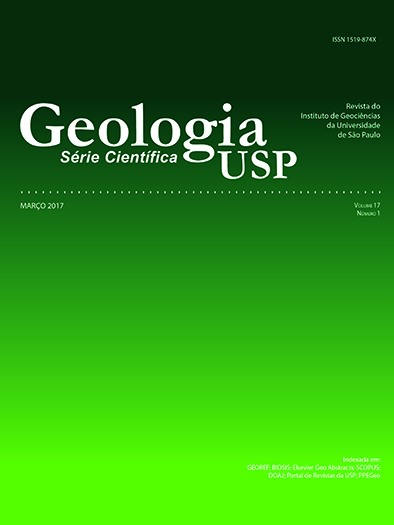Análise estrutural do sistema de grabens do Rio Tocantins, borda oeste da Bacia do Parnaíba (estados do Tocantins, Pará e Maranhão - Brasil)
DOI:
https://doi.org/10.11606/issn.2316-9095.v17-442Palavras-chave:
Bacia do Parnaíba, Sistema de grabens, Estruturas distencionais.Resumo
A borda oeste da Bacia do Parnaíba apresenta estruturas que a diferenciam do contexto em outras regiões na bacia. Destacam‑se duas estruturas do tipo graben (Araguaína e Muricizal), que compõem o sistema de grabens em estudo, a primeira já no interior da bacia, a segunda implantada diretamente sobre o embasamento cristalino (Faixa Araguaia). Nas bordas do graben principal (Araguaína), as formações Motuca e Pedra de Fogo são balizadas por falhas normais ou normais oblíquas sinistrais. Mais a sul, na região de Palmas-Miracema do Tocantins, o Grupo Serra Grande, a Formação Pimenteiras e o embasamento cristalino estão em contato por falhas normais. O segundo graben, localizado a oeste do principal, também acomoda a Formação Motuca e unidades sotopostas, possuindo a mesma orientação. A análise de imagens SRTM auxiliou na cartografia dos fotolineamentos, dos grabens e, associada aos dados de campo, permitiu a proposição de três eventos deformacionais (D1, D2 e D3). A orientação N-S das falhas envolve uma variação de 20º-30º para E ou W, controlada pelas anisotropias do embasamento cristalino nesta borda da bacia, relacionadas à Faixa Araguaia. Falhas de regime normal e normal sinistral evidenciam uma distensão NE durante a formação dos grabens (evento D1). A idade mínima para D1 é estimada no intervalo Permo-Triássico, baseada nas relações estruturais e estratigráficas. Na região norte do mesmo, fotolineamentos E-W/ENE controlam o alojamento de basaltos e diabásios eojurássicos da Suíte Mosquito (evento D2), que interceptam as estruturas do graben principal. A distensão NNE na Suíte Mosquito e falhas normais ou transcorrentes exibindo distensão NW (evento D3) são tentativamente correlacionadas aos eventos de abertura do Atlântico Central e Sul, respectivamente.
Downloads
Publicado
Edição
Seção
Licença
Autores que publicam nesta revista concordam com os seguintes termos:
- Autores mantém os direitos autorais e concedem à revista Geologia USP. Série Científica, o direito de primeira publicação, com o trabalho sob a licença Creative Commons BY-NC-SA (resumo da Licença: https://creativecommons.org/licenses/by-nc-sa/4.0 | texto completo da licença: https://creativecommons.org/licenses/by-nc-sa/4.0/legalcode) que permite o compartilhamento do trabalho de forma não comercial e conferindo os devidos créditos autorais da primeira publicação nesta revista.
- Autores têm autorização para assumir contratos adicionais separadamente, para distribuição não-exclusiva da versão do trabalho publicada nesta revista (publicar em repositório institucional ou como capítulo de livro), conferindo os devidos créditos autorais da primeira publicação nesta revista.
- Autores têm permissão e são estimulados a publicar e distribuir seu trabalho online (em repositórios institucionais ou na sua página pessoal) a qualquer ponto antes ou durante o processo editorial, uma vez que isso pode gerar alterações produtivas, bem como aumentar o impacto e a citação do trabalho publicado (Veja O efeito do Acesso Aberto e downloads no impacto das citações).















